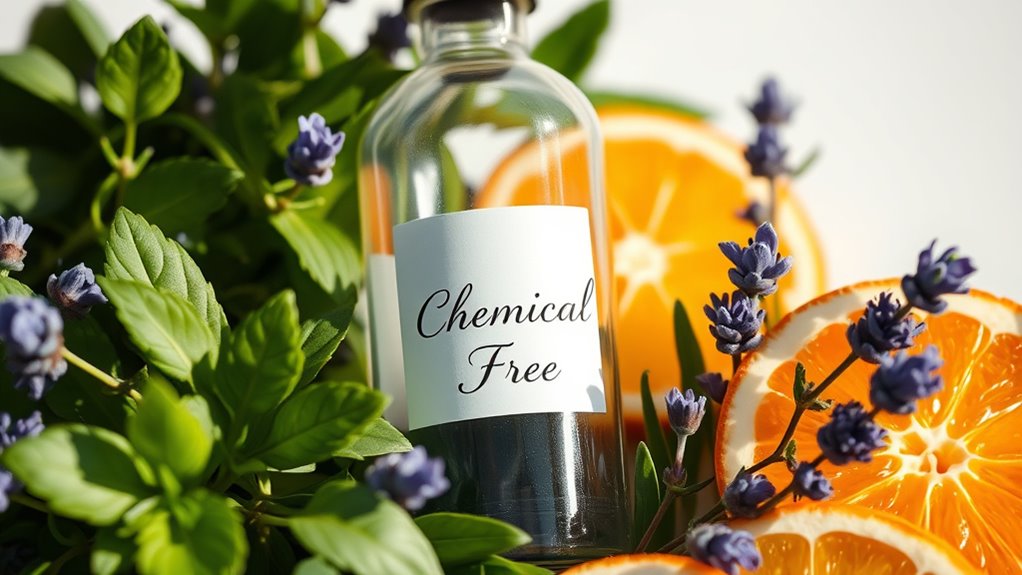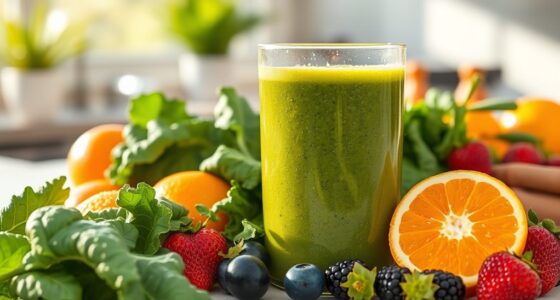“Chemical-free” cosmetics are impossible because everything, including natural ingredients, is made of chemicals. Labels claiming to be chemical-free can be misleading, as all substances are composed of chemicals—water, plants, and synthetic ingredients alike. The key is understanding that both natural and synthetic ingredients are chemicals, and safety depends on their testing and purpose. To make informed choices, it’s important to prioritize ingredient transparency and scientific backing. Keep exploring to learn more about what truly matters in skincare choices.
Key Takeaways
- All matter, including cosmetics, is composed of chemicals; “chemical-free” is scientifically impossible.
- The label often indicates absence of specific synthetic or potentially harmful chemicals, not all chemicals altogether.
- Natural ingredients also contain chemicals; “chemical-free” claims can be misleading and impractical.
- Transparency and ingredient research are essential for making informed, safe choices beyond marketing labels.
- Recognizing that everything is made of chemicals helps consumers focus on ingredient safety and efficacy instead of misleading claims.

Are you concerned about the ingredients in your beauty products? If so, you’re not alone. Many consumers today seek out products labeled as “chemical-free,” hoping they’re choosing safer, more natural options. But it’s important to understand that the term “chemical-free” can be misleading. All matter, including natural ingredients, is made up of chemicals. Even water and plants contain chemicals.
Many assume “chemical-free” means safer, but all ingredients, natural or synthetic, are made of chemicals.
When you see “chemical-free” on a label, it often means the product doesn’t contain certain synthetic or potentially harmful chemicals, but it doesn’t mean the product is completely free of chemicals. This confusion stems partly from consumer perceptions, which tend to equate “chemical” with “synthetic” or “bad,” leading many to prefer products rooted in natural ingredients. These perceptions are driven by a desire for purity, safety, and a more holistic approach to beauty care.
While natural ingredients are often considered safer and gentler, they aren’t automatically better or free from risks. Some natural substances can cause allergic reactions or irritation, especially if you have sensitive skin. It’s a misconception that natural always equals safe. Understanding that both natural and synthetic ingredients are chemicals allows you to make more informed choices.
For example, ingredients like aloe vera or chamomile are natural and soothing, but they still contain compounds that could trigger sensitivities. Similarly, synthetic ingredients such as certain preservatives or colorants are carefully tested and regulated for safety. The key is to look beyond the label and research the ingredients’ purpose and safety profile, rather than relying solely on marketing claims.
Consumer perceptions play a significant role in how these labels influence your choices. Many people associate “chemical-free” with products that are more eco-friendly or healthier, which isn’t always accurate. These perceptions can lead to a preference for products with labels emphasizing “natural” or “plant-based” ingredients, even if those labels aren’t strictly regulated.
It’s essential to scrutinize the ingredient list directly rather than relying on buzzwords. Transparency from brands about their ingredients and the science backing their safety helps you evaluate whether a product truly aligns with your health and environmental values.
Additionally, understanding that everything is made of chemicals can help dispel myths and promote more rational decision-making when selecting cosmetics. Recognizing the difference between natural and synthetic ingredients enables you to make more balanced choices based on the safety and efficacy of individual components. Ultimately, achieving truly “chemical-free” cosmetics isn’t realistic because everything is made of chemicals. Instead, focus on understanding ingredients, considering your skin’s needs, and choosing products from reputable brands that prioritize safety and transparency.
Frequently Asked Questions
Can “Chemical-Free” Products Still Cause Skin Reactions?
Yes, “chemical-free” products can still cause skin reactions. Even if they use natural ingredients, synthetic alternatives or natural compounds might trigger allergy risks.
You should be cautious, especially if you have sensitive skin or allergies. Always read labels carefully, and patch-test new products.
Are Natural Ingredients Always Safer Than Synthetic Ones?
You might think natural ingredients are inherently safer, but that’s not always true. While plant extracts and natural preservatives sound gentle, they can still cause allergic reactions or irritation.
Synthetic ingredients sometimes undergo rigorous testing, making them safer than you’d expect. So, don’t assume natural always means better—evaluate each product carefully, considering potential sensitivities and the quality of ingredients, whether natural or synthetic.
How Do Regulations Define “Chemical-Free” Cosmetics?
Regulatory standards don’t recognize the term “chemical-free” because everything, including water and air, is made of chemicals.
When it comes to labeling accuracy, companies must be truthful about their ingredients, but “chemical-free” labels often mislead consumers. You should look for transparent ingredient lists, as regulations aim to prevent false claims.
Always question vague labels and trust brands that follow strict standards for honest disclosure.
Do “Chemical-Free” Labels Mean the Product Is Organic?
Think of a “chemical-free” label as a mirage—promising purity but often hiding complexity. You might believe it’s organic, but marketing claims can be misleading, shaping your perception more than facts.
Just because a product claims to be chemical-free doesn’t mean it’s organic or natural; it’s more about how companies craft their image. Always look beyond the label to understand what’s truly inside and what influences your choices.
What Are Common Chemicals Found in “Chemical-Free” Products?
You often find chemicals in products labeled as “chemical-free,” but many contain natural preservatives like essential oils or plant extracts, and synthetic additives such as fragrances or stabilizers.
These ingredients help preserve the product and improve texture or scent. While the label suggests no chemicals, it’s important to read ingredient lists carefully, as some so-called “chemical-free” products still contain substances that serve specific functions.
Conclusion
Remember, claiming “chemical-free” is like trying to find a unicorn—there’s no such thing in cosmetics. Everything, even natural ingredients, are chemicals. Think of your skincare as a garden: not all weeds are bad, and not all chemicals are harmful. Instead of chasing an impossible label, focus on what truly benefits your skin. Embrace the truth behind the label, and you’ll steer clear of false promises, nurturing your skin like a well-tended, thriving garden.








